
FS-2025-0753 | May 2025
Apple Red Skin Coloration: A Grower's Checklist
By Matthew Trause, James Schupp, Ph.D., and Macarena Farcuh, Ph. D.
Color Importance
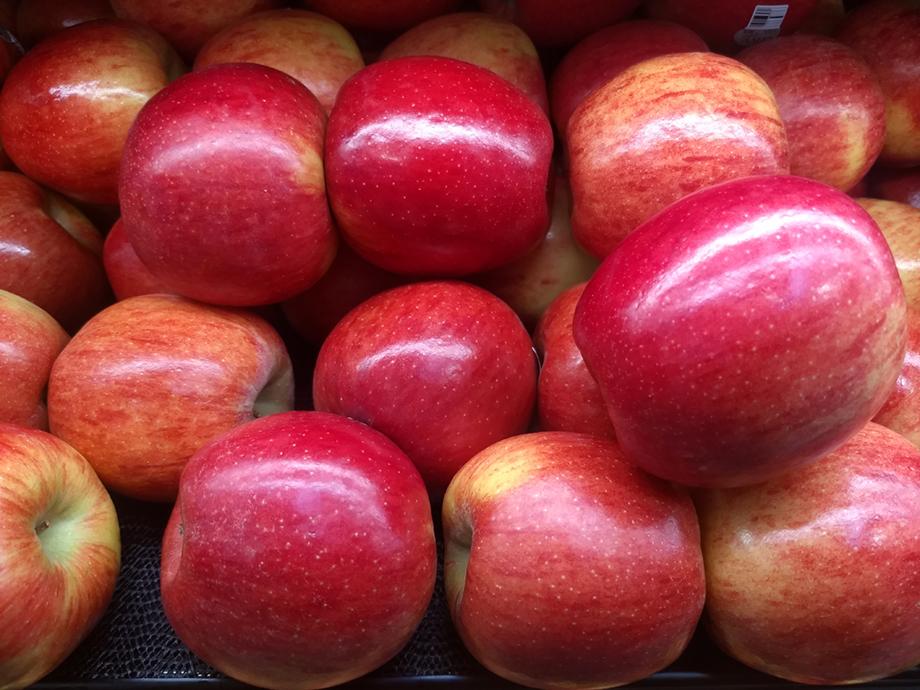
For apple growers, developing strategies on how to improve apple’s red skin coloration is a major step towards increasing fruit marketability and profitability. Red skin coloration is highly associated with sales, as vibrantly colored fruits are more appealing to the consumer’s eye, as well as to consumer’s palate. In fact, there is no evidence of a link between red color and poor taste. In addition, darker fruit coloration is associated with increased nutritional value and antioxidant properties that have many health benefits. However, in the last few years, reaching the 50-60% red skin coloration required by retailers, particularly in highly profitable early-season varieties such as Honeycrisp, has been a major challenge in the mid-Atlantic region.
Pigments Involved in Color Development
There are mainly three pigments concentrated in apple’s skin that determine its coloration: anthocyanins, carotenoids, and chlorophylls. Of these three, anthocyanins play the most significant role in the skin coloration process.
Anthocyanins are a set of phenolic compounds which are the main pigments in fruits, generating their characteristic blue, purple, or reddish hues. The content and composition of anthocyanins mainly determine the intensity and quality of red skin coloration in apples. Anthocyanins, along with other phenolic compounds, are strongly associated with improved antioxidant activity in fruits and can also improve their nutritional value, hence increasing health benefits for consumers.
Other pigments contribute to the color of apples, such as carotenoids and chlorophylls. Carotenoids lend a yellow or orange color to fruit, with chlorophylls adding a green hue.
Chlorophylls are concentrated in a greater proportion in unripe fruit and decrease as the fruit ripen. These pigments are synthesized through multi-step biochemical processes, or from a chain of chemical reactions. These processes are regulated, directly or indirectly, by factors such as genetic background, developmental stage of the fruit, nutritional status, canopy architecture, and crop load, but also are strongly affected by environmental factors such as temperature and light.
Environmental Factors
The two main environmental factors that affect apple red skin coloration development are temperature and light.
Temperature
The ideal conditions for red color development in apples correspond to bright, clear days with temperatures of around 77ºF (25ºC) and cool nights (59ºF, 15ºC) throughout preharvest (3 weeks before harvest). When exposed to these conditions, trees are not stressed during the day, which increases their canopy photosynthesis and decreases their respiration rates at night. Increasing photosynthesis promotes the accumulation of sugars (carbohydrates), and decreasing respiration rates help to decrease the breakdown of sugars. Therefore, under the above temperature conditions more carbohydrates are readily available. This is crucial, as sugars constitute the raw material for the production of anthocyanins.
Anthocyanin biosynthesis is suppressed at warmer temperatures. Hot days (>90ºF; >32ºC) and warm nights (>68ºF, >20ºC) make it difficult for trees to produce apples with the desired red skin coloration during hot seasons, especially for early-harvest varieties such as Honeycrisp.
Light
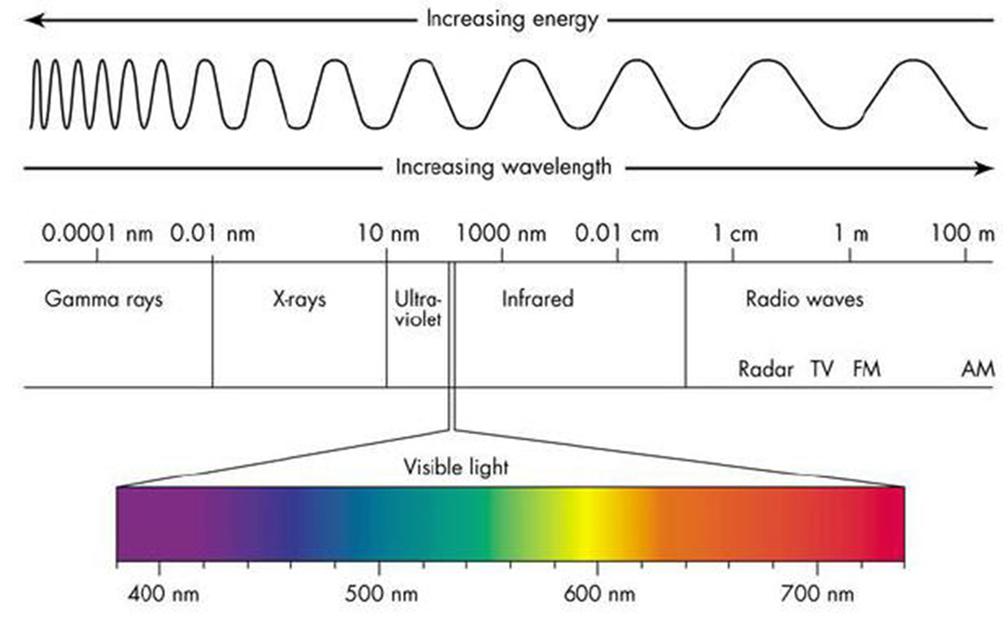
ultraviolet light, which promotes red coloration.
Source: Lumenistics, 2012.
Light intensity and quality (wavelength) are also crucial factors affecting apple red skin coloration during development and ripening. This is particularly important as all of the chain of biochemical reactions involved in the synthesis of anthocyanins are induced by light. Skin color pigments are synthesized as a response to stressors such as sunlight, specifically in the ultraviolet (UV) radiation wavelengths. UV radiation wavelengths are shorter and higher energy than visible light that we see as colors (Figure 1). Therefore, the more that apples are exposed to the sun’s rays – specifically UV wavelength – the more color that the fruits will develop on the skin, but only to a certain limit. Too much UV radiation can cause fruit sunburn, just like in human skin.
Sub-optimal temperature and light conditions present in the mid-Atlantic at the time that varieties such as Honeycrisp are harvested in recent years have resulted in a poor or marginal red skin coloration development in these varieties. As environmental conditions are difficult to control, the focus must be placed on managing the tree, its physiology, and a uniform light distribution for improving coloration. These can be often optimized by picking the best site for an orchard.
Site of Orchard Establishment
Elevation
The altitude at which fruits are grown can also have an important effect on apple red skin coloration. Cooler temperatures and higher elevation areas will maximize fruit color. The necessary temperature differential between daytime and nighttime will increase anthocyanin accumulation and thus development of red skin coloration.
Aspect
Aspect, or the angle at which that the sun hits the earth, can also impact the development of red skin coloration. The sun’s rays shine more directly on the southern than it does the northern side, resulting in south-facing fruits receiving much more UV radiation from the sun than a northern facing counterpart.
Soils
The quality of the orchard’s soil also affects red color development. The soil’s natural water- and mineral nutrient-holding capacity can affect red color directly, through nitrogen (N) availability (high N delays chlorophyll disappearance), and indirectly, by promoting tree vigor and the potential for shading within the canopy.
Cultivars, Strains and Rootstocks
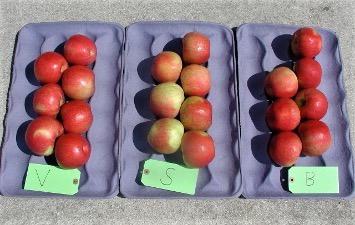
right) with standard strain (center). Photo: J. Schupp
The maturity date of a cultivar or strain depends on the temperature range encountered at fruit maturity. Recent years’ prolonged warm spells in August and September have resulted in insufficient red color of early-ripening cultivars such as Gala and Honeycrisp. Warm harvest weather, combined with the industry’s ever-stricter color grading standards, may result in loss of value, particularly with older, less red strains of these cultivars. Consequently, in recent years newer highly colored strains of Gala, such as Gale, Buckeye, and Brookfield, have become predominant throughout the industry. Until recently, the supply of Honeycrisp apples lagged behind consumer demand, which provided some insulation from the need to plant redder strains, but this phase of the Honeycrisp market has ended and nowadays the aim is to meet the strict red color standards to obtain a higher market value. Growers should replace older selections that can no longer meet color standards with red strains, such as Firestorm, Royal Red, and B42 Honeycrisp (Figure 2).

Red apple strains have often been viewed unfavorably due to poor management throughout the fruit production chain, which has led to a suboptimal quality perception by consumers of certain Delicious strains. There is no evidence of a link between red color and poor taste of redder strains of other cultivars, including Gala and Honeycrisp. Sensory studies of B42 Honeycrisp and a standard strain conducted at Penn State showed that panelists could distinguish no difference between the strains in taste or texture and that they preferred the appearance of B42 over the standard strain.
Red strains may become red enough for sale before they are ripe enough to eat. Growers do need to make sure that the maturity of harvested fruit is appropriate for its intended use and storage period.
Size-controlling rootstocks reduce canopy volume and density, resulting in increased light distribution and improved red fruit color. Tree vigor must be strong enough to develop the orchard’s full productive potential, yet result in a balanced tree at maturity. Growers should plant the most dwarfing rootstock manageable given the inherent vigor of both the soil and the cultivar, as the former can negatively affect fruit coloration even in a dwarfing rootstock (Figure 3).
Mineral Nutrition
Balanced mineral nutrition is critical to achieving high marketable yields of attractive red fruit. Although all mineral nutrients are needed to achieve balanced growth and fruit quality, two minerals stand out when focusing on red color—nitrogen and potassium.
Adequate leaf nitrogen is required for high productivity, but excess N is detrimental to red coloration. High N delays chlorophyll disappearance in the peel and results in a dull muddy color. Excess N also promotes vegetative growth which can result in shading and loss of red color. It is important to understand that cultivars differ in sensitivity to N. For example, Gala color is less sensitive to N, and leaf N levels of 2.1- 2.3% will improve tree vigor and fruit size without being detrimental to color. Conversely, Honeycrisp, Jonagold, and Fuji are sensitive, and leaf N should be managed in the range of 1.8-2.0% to maintain good red color and prevent excessively large fruit.
Low potassium (K) results in poor fruit color. The optimal range for leaf K in apples is 1.5-2.5%, and it should be noted that apple fruit are high in K. Growers therefore need to actively manage this mineral to replace that which is being removed by the crop. Correcting low K levels can produce a rapid and dramatic improvement in red fruit color. While some believe that “More K is better”, there is no evidence that excess K can increase red color, but there is ample evidence to show that excess K can make bitter pit worse in Honeycrisp.
Crop Load Management
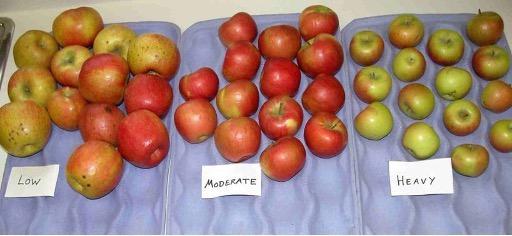
An excessive crop causes trees to produce fruit with a poor red skin coloration (Figure 4). The lack of red coloration is due to a shortage of resources, specifically sugars and nutrients reaching each fruit due to increased competition. The lower sugar contents limit the fruit’s ability to synthesize anthocyanins, thus preventing red skin coloration development. Excessive crop loads in varieties such as Honeycrisp are particularly harmful as the high depletion of sugars will affect fruit coloration development of the current year’s production, as well as the juvenile buds that will develop into next year’s crop.
Low crop loads, on the other hand, will promote tree vigor and vegetative growth, consequently affecting red skin color development as the few apples that are left on the tree will be shaded and thus will not receive the necessary sunlight required for anthocyanin biosynthesis. This will also limit total crop yield and profitability.
Therefore, crop load management must be targeted towards a balanced orchard. The optimal recommended crop load is around 7-8 fruits per cm2 Trunk Cross-Sectional Area (TCSA). This will increase red skin coloration and maintain adequate fruit size, while maintaining return bloom for the coming year.
Fruit Maturity Management
Fruit maturity is also a critical factor affecting apple red skin coloration as anthocyanin synthesis is developmentally regulated, occurring mainly during fruit ripening. Therefore, controlling how and when apple fruit ripen will impact red coloration development. Ethylene, which is a gaseous plant hormone controlling ripening, can be regulated with the use of preharvest plant growth regulators, such as Ethephon, ReTain® or Harvista®.
Ethephon (available as Ethrel®, Bayer Crop Science; MotivateTM, Fine Americas; or Ethephon 2, Arysta LifeScience North America, LLC), which is an ethylene-releasing chemical, promotes fruit ripening and can help increase red coloration, but if temperatures are above optimal, it will only advance maturity without increasing red coloration. Ethephon also accelerates fruit abscission and may negatively impact fruit storability.
ReTain® (active ingredient: Aminoethoxyvinylglycine (AVG), Valent USA) will inhibit ethylene production, delaying fruit ripening as well as color development.
Harvista® (active ingredient: 1-Methylcyclopropene (1-MCP), AgroFresh), will bind to ethylene receptors in the fruit, blocking its perception. This prevents the fruit‘s response to ethylene, therefore delaying ripening.
ReTain® and Harvista® will lead to fruit staying on the tree for a longer time, preventing fruit drop. If this delay shifts maturity into a cooler weather window, it may help fruit reach optimal coloration. Additionally, these chemistries increase maturity consistency throughout the orchard, which helps managing fruit harvest windows.
Please note that the use of a product name in this factsheet does not imply endorsement of the product to the exclusion of others that may be suitable.
Light Management
Light is one of the critical factors affecting apple red skin coloration. However, growers need to embark on canopy light management with caution to avoid fruit skin experiencing excessive exposure. There are several ways to manage sunlight in the canopy. Pruning, plant growth regulators, and use of reflective mulches are the most popular techniques.
Pruning
Pruning is the long-established method of increasing light distribution in the canopy to promote red fruit color and other light-driven processes, such as flowering and fruit set. Conduct annual dormant pruning, making thinning cuts to remove entire limbs at their point of origin. This type of cut slows and limits the amount of regrowth, thus thinning out the branches and creating windows where sunlight can penetrate the canopy. Remove the largest limbs, especially in the top half of the tree, to create a cylindrical or cone shaped canopy. Then thin out additional limbs to space them out both radially and vertically. When tree vigor is strong, summer pruning to remove upright shoots and leaves can confer a temporary increase in sunlight. Schedule the summer pruning about two weeks before the start of harvest to provide additional sunlight to promote red coloration.
Root pruning is another technique to reduce canopy vigor and improve red color. Root pruned trees have shorter shoots and smaller leaves, contributing to increased light penetration. Root pruning is done with a tractor-mounted subsoiling blade or coulter wheel mounted offset on a tool bar. To be effective, root pruning should be performed early in the season just prior to or at the start of growth. Cutting both sides of the row at 16-18 inches from the trunk removes enough roots to have an effect.
Plant Growth Regulators (PGRs)
PGRs containing the active ingredient prohexadionecalcium (PCa) (Kudos™, Fine Americas; Apogee™, BASF) can be used in combination with pruning to reduce vegetative growth and improve light distribution. PCa reduces shoot elongation, resulting in a more compact canopy with improved exposure to light.
Reflective Mulches
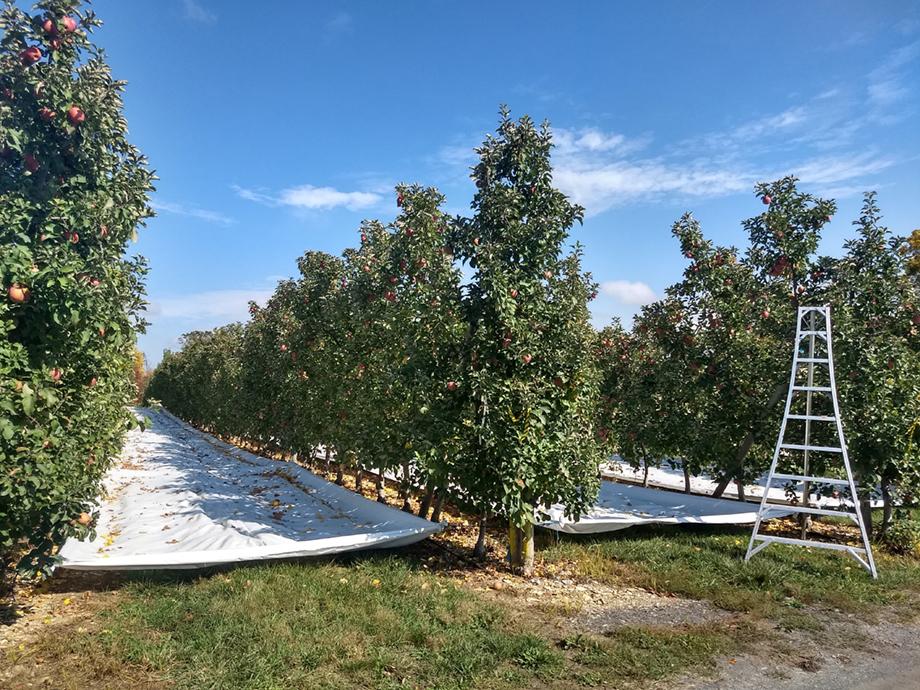
Groundcovers made with reflective material are a pre-harvest management tool that improves the tree canopy light environment. Reflective groundcovers in apple orchards essentially bounce the light reaching the orchard’s floor back up into the canopy, enhancing the capacity of apple trees to harness sunlight (Figure 5). This increases the amount of light reaching the apple fruit surface and exposes more apples to light within the orchard. This improved light environment is used by the tree to power its production of sugars, increasing fruit size and red skin coloration. The use of reflective mulches can particularly increase light penetration in the inner and lower parts of the canopy, which generally receives less light.
There are multiple types of reflective groundcovers on the market, such as white reflective fabrics (available as Extenday or ProLine) or metallic films (such as Mylar®). White reflective fabrics can last for up to seven years and can be rotated throughout the orchard. Metallic films have lower costs but usually are disposed after one season. When purchasing, make sure that the chosen fabric reflects radiation in the UV range, as this is the wavelength that will promote red coloration. It is crucial to install these groundcovers around three to four weeks before anticipated harvest.
Summary
The importance of fruit color cannot be underestimated, as it can increase sales in the marketplace and increase your profits. Remember that a deeply colored skin has nutritional benefits, since a darker color indicates the presence of a high concentration of antioxidants. Replace older, less colored orchards with improved red strains when they become available. Since growers cannot control temperature, it is important to control other factors of color development. Use leaf and soil analysis to maintain moderate tree vigor, with adequate levels of N and K. Use thinning cuts during dormant pruning to create a narrow canopy and reduce shading from excess branching. It is important to get a significant amount of UV radiation from sunlight in the last few weeks of ripening to get the best color. If standard methods are not working well, consider plant growth regulators to reduce vigor or alter the maturity window, or installing reflective mulches to maximize the UV radiation that reaches the apples.
Works Consulted
Honda, C., Moriya, S. (2018). Anthocyanin Biosynthesis in Apple Fruit. Hortic. J. 87: 305–314. https://doi.org/10.2503/hortj.OKD-R01
Johnson, E., Farcuh, M. (2024). Aminoethoxyvinylglicine and 1- methylcyclopropene: Effects on Preharvest Drop, Fruit Maturity, Quality, and Associated Gene Expression of ‘Honeycrisp’ apples in the US Mid-Atlantic. Plants 13(17): 2524. https://doi.org/10.3390/plants13172524
Marini, R. (2024). Fruit Color - Promoting Red Color Development in Apple. Penn State University. https://extension.psu.edu/fruit-color-promoting-red-color-development-in-apple.
Miah, S., Farcuh, M. (2024). Combining the Use of Reflective Groundcovers and Aminoethoxyvinylglycine to Assess Effects on Skin Color, Preharvest Drop, and Quality of ‘Honeycrisp’ Apples in the Mid-Atlantic USA. Horticulturae 10(2): 179. https://doi.org/10.3390/horticulturae10020179
Schupp, J.R., Greene, D.W. (2004). Effect of Aminoethoxyvinylglycine (AVG) on Preharvest Drop, Fruit Quality, and Maturation of ‘McIntosh’Apples. I. Concentration and Timing of Dilute Applications of AVG. HortScience 39: 1030–1035.
Wünsche, J.N., Lakso, A.N., Robinson, T.L., Lenz, F., Denning, S.S. (1996). The Bases of Productivity in Apple Production Systems: The Role of Light Interception by Different Shoot Types. J. Am. Soc. Hortic. Sci. 121: 886–893.
MATTHEW TRAUSE
B.S. in Food Science, University of Maryland, College Park.
mtrause@terpmail.umd.edu
JAMES SCHUPP, PH.D.
Professor Emeritus of Pomology, Pennsylvania State University, Fruit and Research Extension Center, Biglerville, PA.
jrs42@psu.edu
MACARENA FARCUH, PH.D.
Assistant Professor and Extension Specialist, University of Maryland, College Park.
mfarcuh@umd.edu
This publication, Apple Red Skin Coloration: A Grower’s Checklist (FS-2025-0753), is a part of a collection produced by the University of Maryland Extension within the College of Agriculture and Natural Resources. The information presented has met UME peer-review standards, including internal and external technical review. For help accessing this or any UME publication contact: itaccessibility@umd.edu
For more information on this and other topics, visit the University of Maryland Extension website at extension.umd.edu
University programs, activities, and facilities are available to all without regard to race, color, sex, gender identity or expression, sexual orientation, marital status, age, national origin, political affiliation, physical or mental disability, religion, protected veteran status, genetic information, personal appearance, or any other legally protected class.
When citing this publication, please use the suggested format:
Trause, M., Schupp, J., & Farcuh, M. (2025). Apple Red Skin Coloration: A Grower’s Checklist (FS-2025-0753). University of Maryland Extension. go.umd.edu/FS-2025-0753.
Other resources
-
How Can Growers Determine Apple Fruit Maturity and Optimal Harvest Dates? (FS-1180) >
How Can Growers Determine Apple Fruit Maturity and Optimal Harvest Dates? (FS-1180) > -
Important Apple Cultivars in the Mid-Atlantic Region (EB-2023-0684) >
Important Apple Cultivars in the Mid-Atlantic Region (EB-2023-0684) >